The Bundesliga is currently standing still which allows us to take an in-depth look at some of the underestimated sides of the league. And although SC Paderborn are sitting at the bottom of the table, Steffen Baumgart’s team regularly impressed with their style of play and their trust in their own game model.
In the following tactical analysis, we examine Paderborn’s attacking and defending tactics in the German top flight and explain the key concepts of Baumgart’s side.
Tactical systems
Throughout the 2019/20 season Paderborn deployed different back four systems mainly preferring a 4-4-2 formation. However, they also played within a 4-3-3 or 4-4-1 system at times.
The biggest differences in their setup lie in their midfield structure. While they play with a single pivot and two advanced midfielders in their 4-3-3, they deploy a double pivot when playing in a 4-4-2. As a consequence, Paderborn have an extra man in midfield playing within a 4-3-3 system while they can attack with striking duo in their 4-4-2 system.
Below we can see the average positioning within their 4-4-2 shape from their first Cup game this season. One can see a flat back four due to the deep positioning of the full-backs as well as an emphasis on playing through the left side. Moreover, one of the central midfielders moves slightly higher while the other one stays centrally in front of the centre-backs. The wingers are the main passing outlets for the full-backs and central midfielders playing forward being positioned in the wider areas and sometimes in the half-spaces.
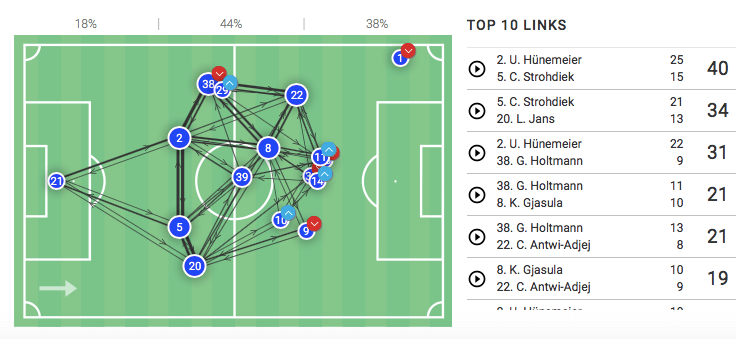
In comparison to that, the next graphic shows their positioning & passing network from their game against Mainz. They deployed a 4-3-3 system with a midfield three in the centre as can be seen. The back four is still very flat though and the wingers mainly act in wide areas. Their emphasis on playing through the left side is still noticeable.
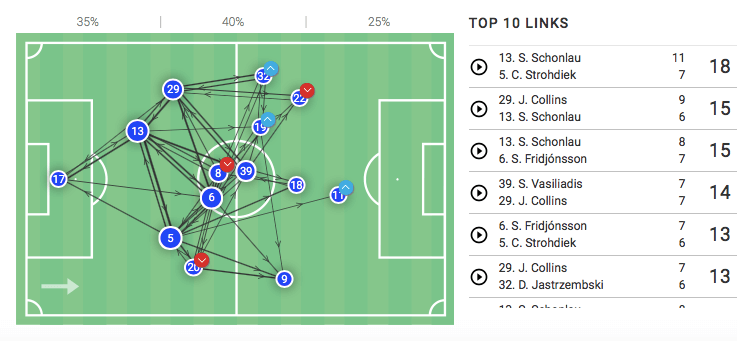
Build-up play
Different to sides who favour a risk-minimised approach as the underdog of the league, Paderborn do not hit the ball long and attempt to win second balls in midfield without committing the risk of losing the ball during a possession phase. Paderborn attempt to utilise short pass combinations to attract the opposition and then exploit the created space in ball far areas.
A team that concedes 12.61 shots on average per 90 minutes will logically also have a higher amount of goal-kicks compared to the top sides conceding only 8 to 10 shots on average. Paderborn coach Baumgart seems to take this rather as a chance and occasionally surprises with elaborate strategies on how to play out from the back against the high press most sides execute against the bottom-placed club. With a PPDA against of 9.1 (passes allowed per defensive action), Paderborn rank third in the league which underlines that they are rarely given the freedom to build-up play without being pressed intensely.
In order to play out from the back, it is essential to use the spare man. Since the opposition often keep an extra defender at the back to avoid man-to-man situations within the back line, there should always be a numerical superiority during build-up. If the opposition press man-to-man, the goalkeeper creates the numerical advantage.
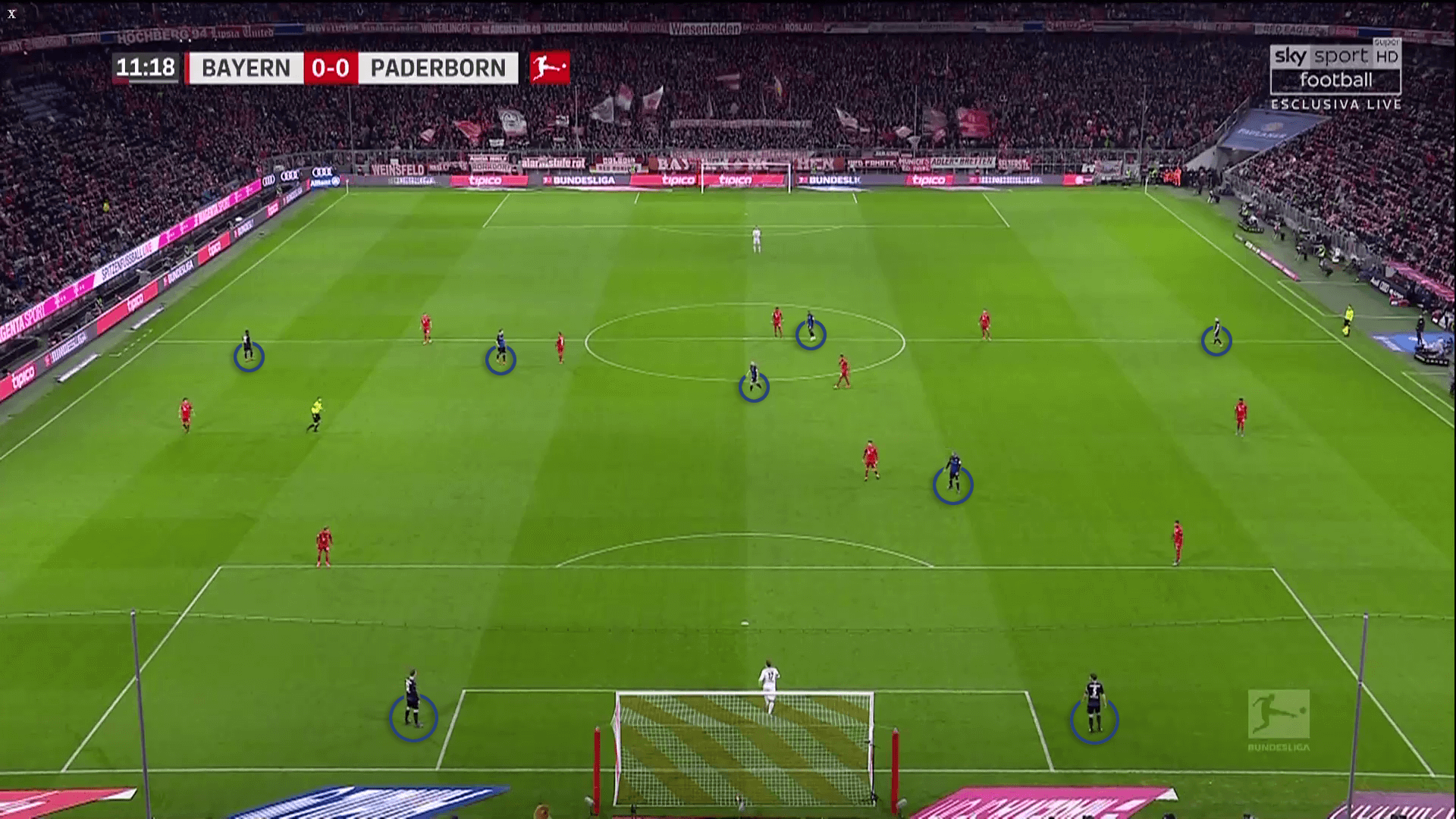
Paderborn attempt to utilise this spare man to play out from the back. Throughout the season, one could notice different strategies from goal-kicks. If the opposition press man-to-man, Paderborn will play short first to attract pressure and then try to play the ball forward as soon as possible and to get behind the opposition defence in order by taking advantage of the numerical equality up front.
Most of the times, the opposition will attempt to press Paderborn’s back four with a maximum of three players though. As a consequence, their spare man will often be either of the full-backs which allows Paderborn space in wider areas to play out from the back. Therefore, Paderborn usually occupy the flanks with two players on each side, the wingers and the full-backs. The latter ones stay rather deep and therewith enable Paderborn to bring the ball into wide areas early during their build-up phase.
Their tendencies to play through the wings and to overload the wide areas decrease the risk of dangerous counter-attacks if Paderborn lose the ball. Firstly, the distance towards their own goal is bigger when playing through the flanks. Secondly, with there help of the sideline, they can press the opposition in case of losing the ball.
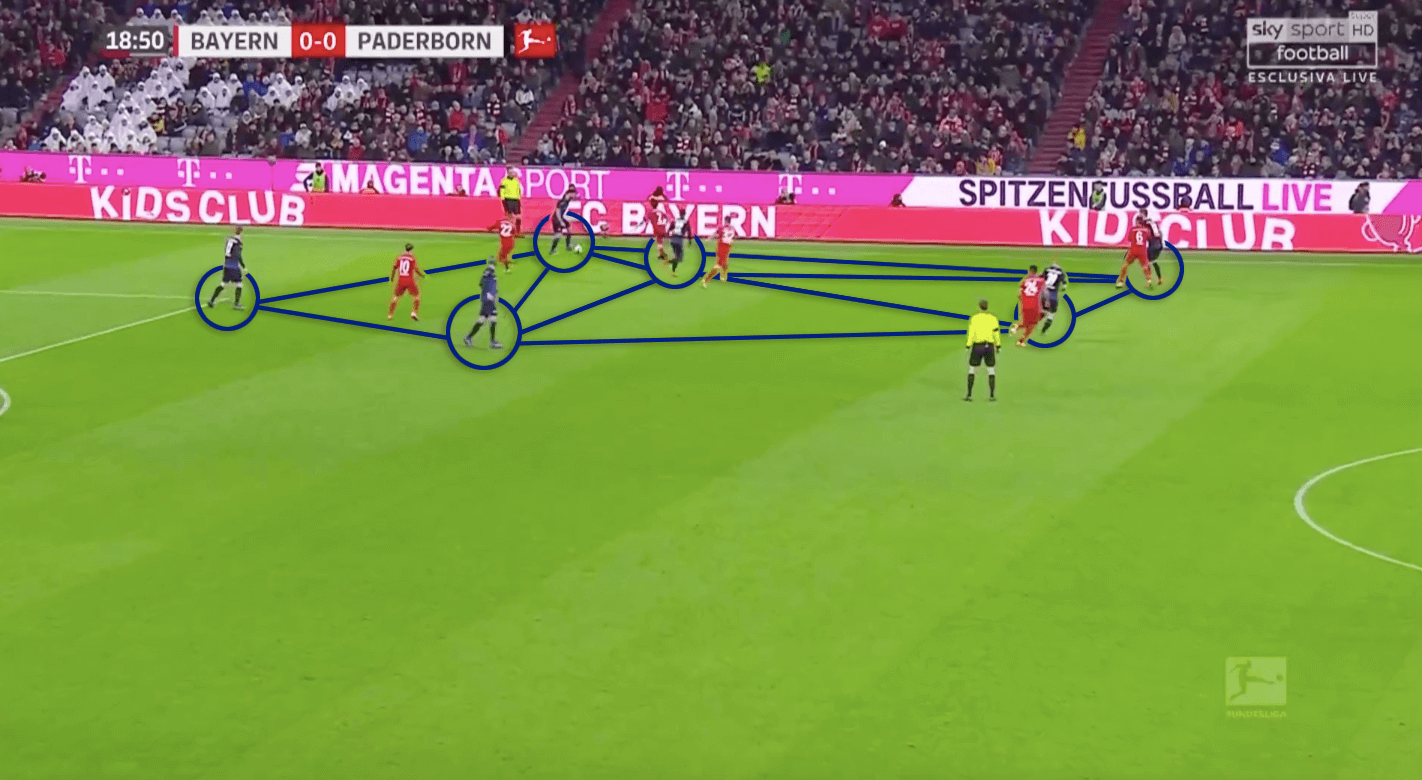
Final third strategies
Something which one would not directly expect from the bottom club is that they hold the second-highest value of 1vs1 dribblings (34.05 per 90 minutes) just behind Bayern Munich (34.47 per 90).
Of course, Paderborn do not commit as many players forwards as other teams which makes them more dependent on dribblings to outplay the opposition defence, but if one takes into account that they also have got less possession (46.8 % possession on average), their amount of dribblings is even more stunning.
The deep positioning of the full-backs also opens up passing lanes towards the wingers. This also has a consequence on their final third strategies as the wingers are offered more space out wide which can be used in isolated 1v1 situations for dribblings than if they tucked inside. By taking on the opposition full-back the winger attempts to get behind the opposition back line to get into a better position for crossing. In the image below, one can see such a common scenario. After beating the defender in a 1v1, Paderborn’s winger can serve a ball for the attackers and midfielders which occupy the box. That way they score against RB Leipzig.
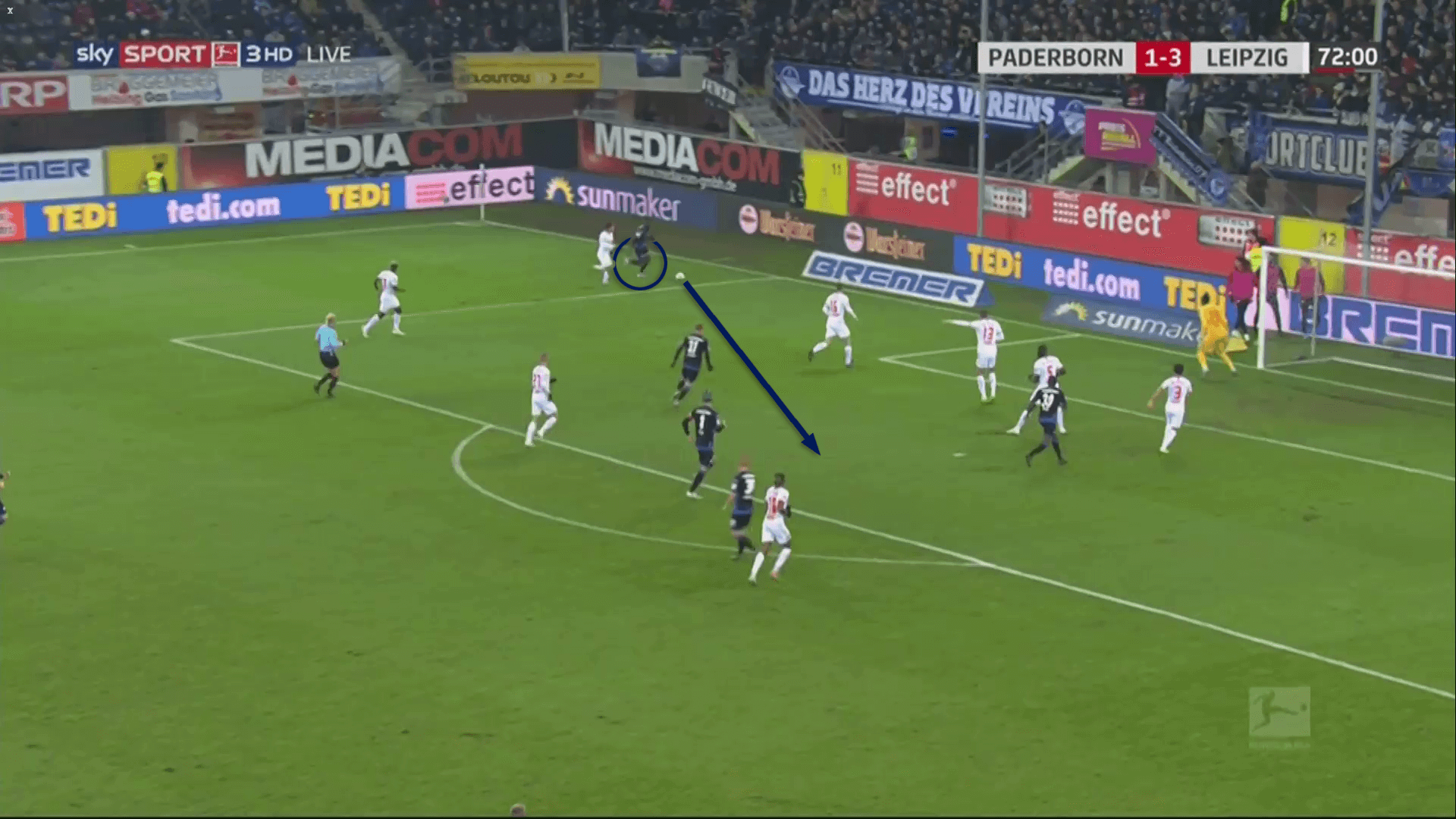
As for their build-up phase, during positional attacks, Paderborn often try to create scoring opportunities through wide areas. With their two wide players and the ball near midfielder, they create triangular shapes and attempt to break the opposition with dynamic actions. Either the full-backs or the central midfielders would overlap (only FB) or underlap (FB or CM) if the winger is in possession while the central midfielders often also provide an option to play into the ball near half-space. In the scenario displayed below, the winger received the ball from the left-back and played the ball into the forward run of the central midfielder.
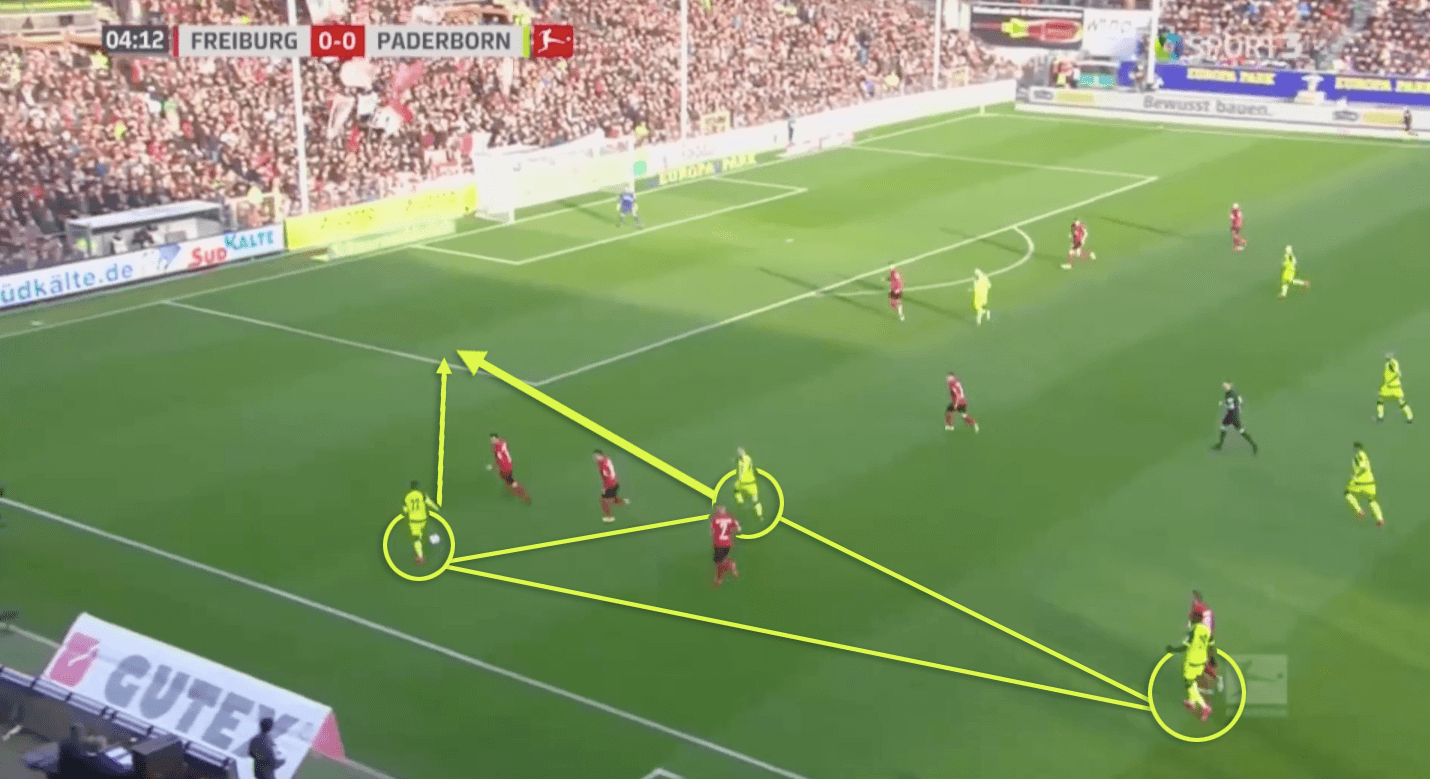
One of the bigger issues of Paderborn in the attack is the quality of their chances. Due to a suboptimal shot selection, they often even do not hit the target, because the defenders can block the shot or the angle is simply too bad which decreases the probability of scoring. Their xG value per shot is 0.098 which is the second-lowest value of the Bundesliga in 2019/20.
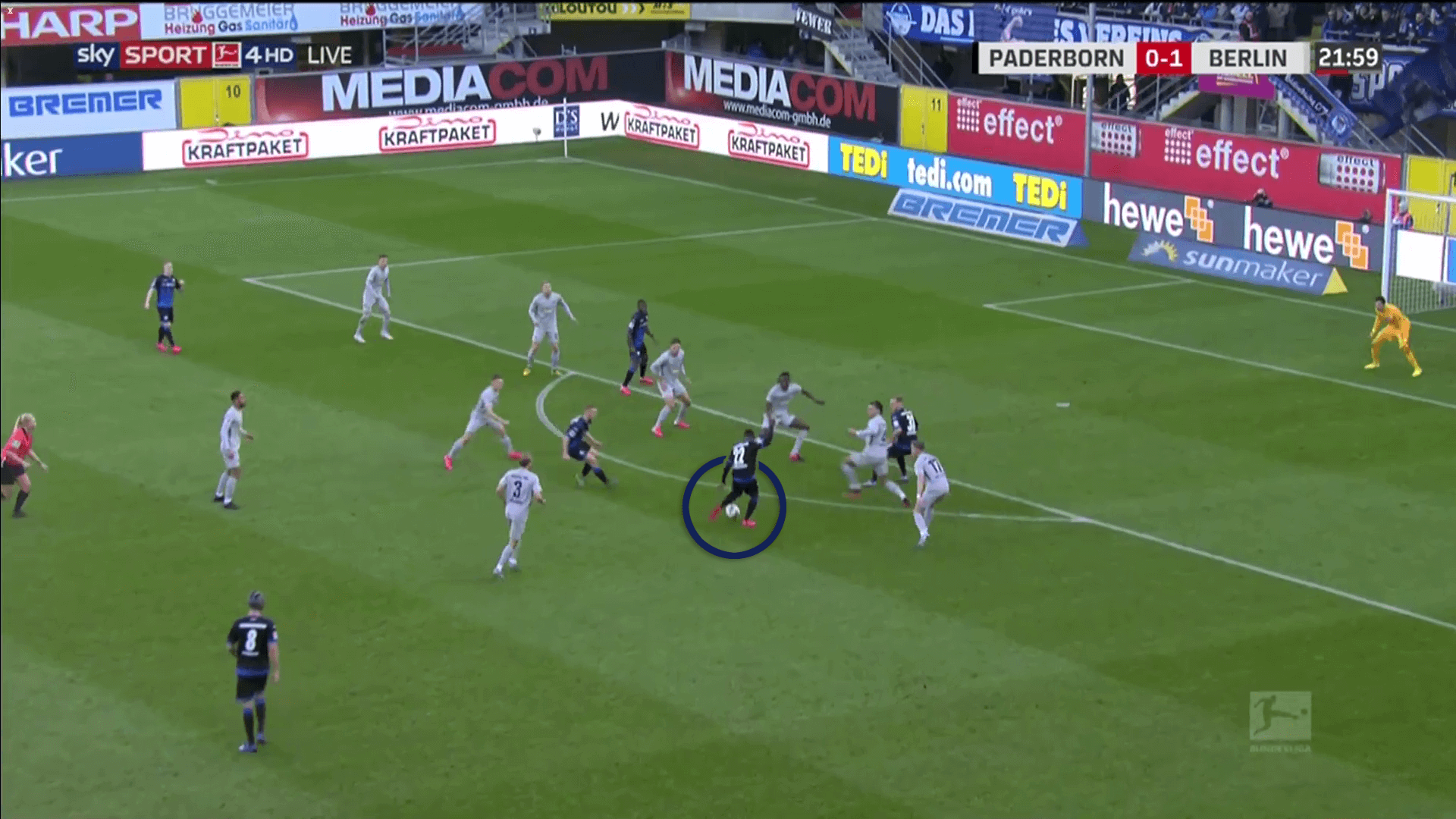
Press & defensive issues
Their PPDA value of 12.79 (passes allowed per defensive action) shows that they do not maintain an intensive pressing throughout the whole game. But they always aim at actively shutting down all passing lanes available to the opposition as early as possible and therewith forcing them into mistakes.
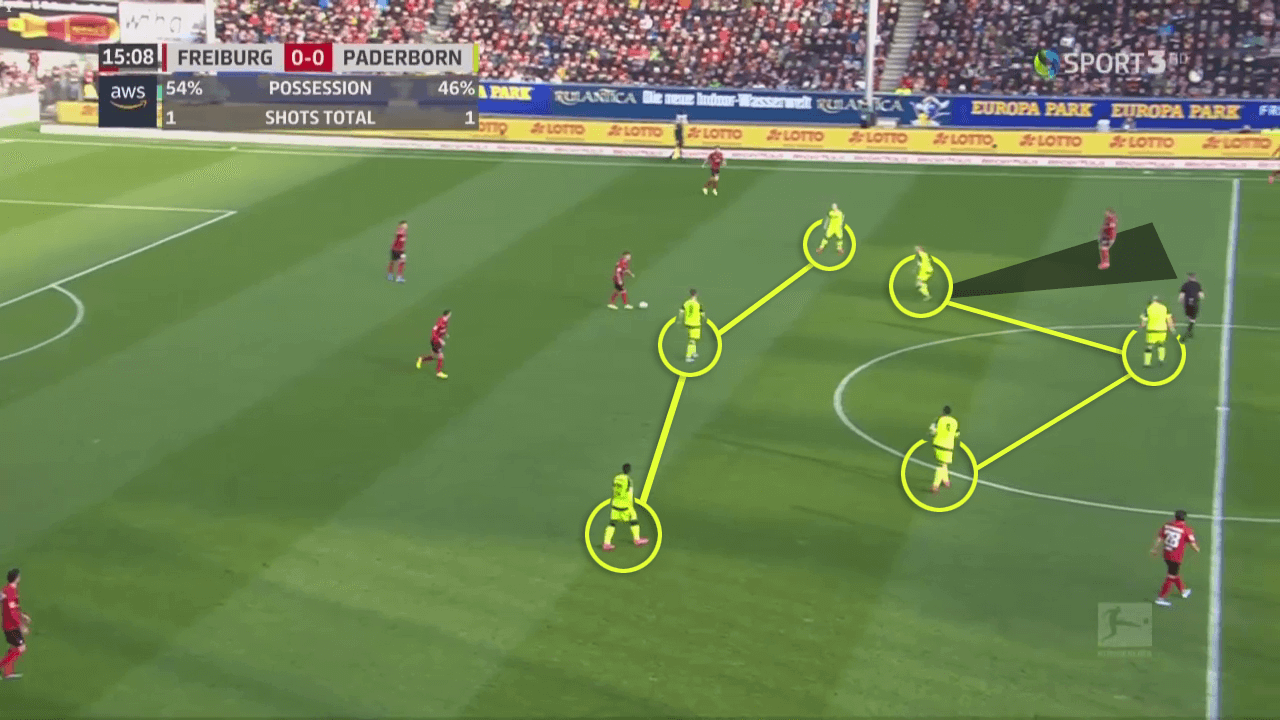
The first goal of Paderborn’s press is to prevent the opposition to play into midfield with the option to receive and turn. Therefore, they use triangular shapes and cover-shadows within their 4-3-3 or 4-4-2 structure. As one can see in the image above, they are not afraid to position their midfielders in front of the opposition midfielders. Below, we’ve displayed a situation from their game against Bremen where they press a bit more cautious within a 4-4-2 shape.
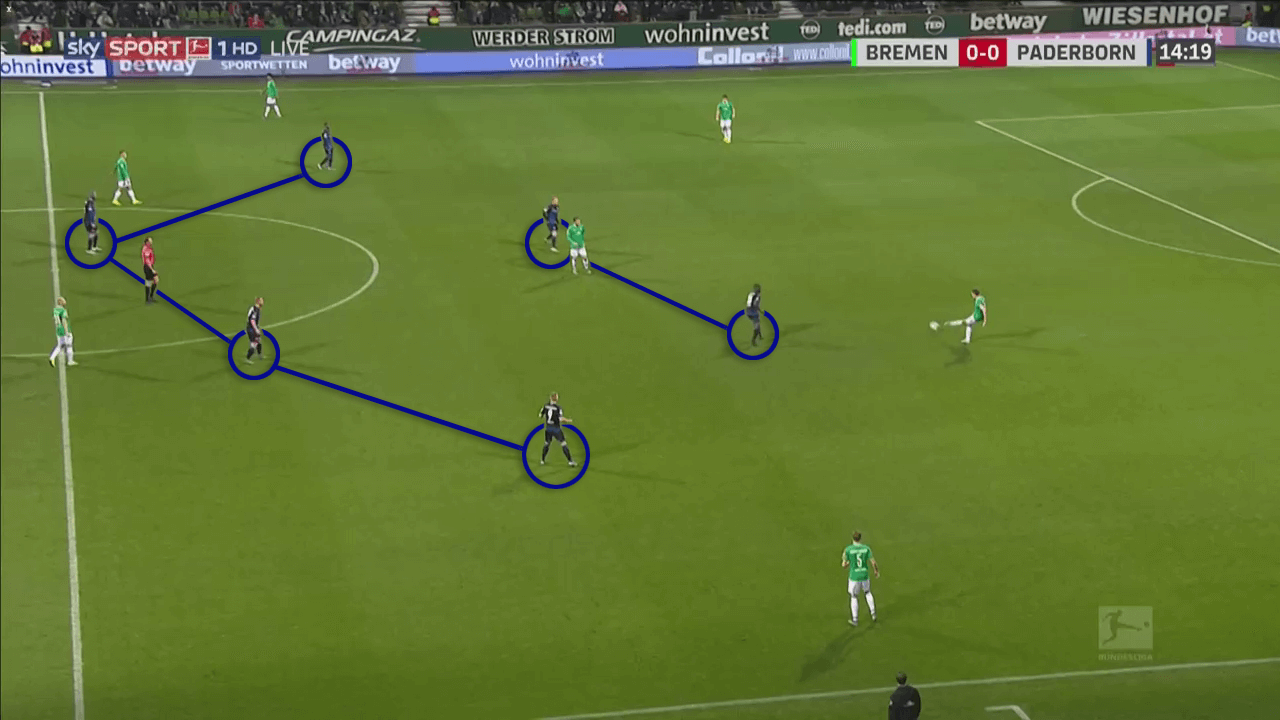
Noticeable is also that Paderborn have got only 16 points despite an expected points value of 25. The reason for this mainly lies in the amount of conceded goals of 54 goals despite an xGA value of 42.78 according to Wyscout.
One of Paderborn’s issues, is their missing vertical compactness on occasion. If the opposition overplay the midfield with a long ball, Paderborn often offers space in the middle third of the pitch where they then get outnumbered. That is mainly as they commit a lot of players forward during the press and their midfielders often step out to press. That leaves them in a disadvantageous position if being overplayed. In case of a long ball, the back four drops and therewith further increase the space between defence and midfield.
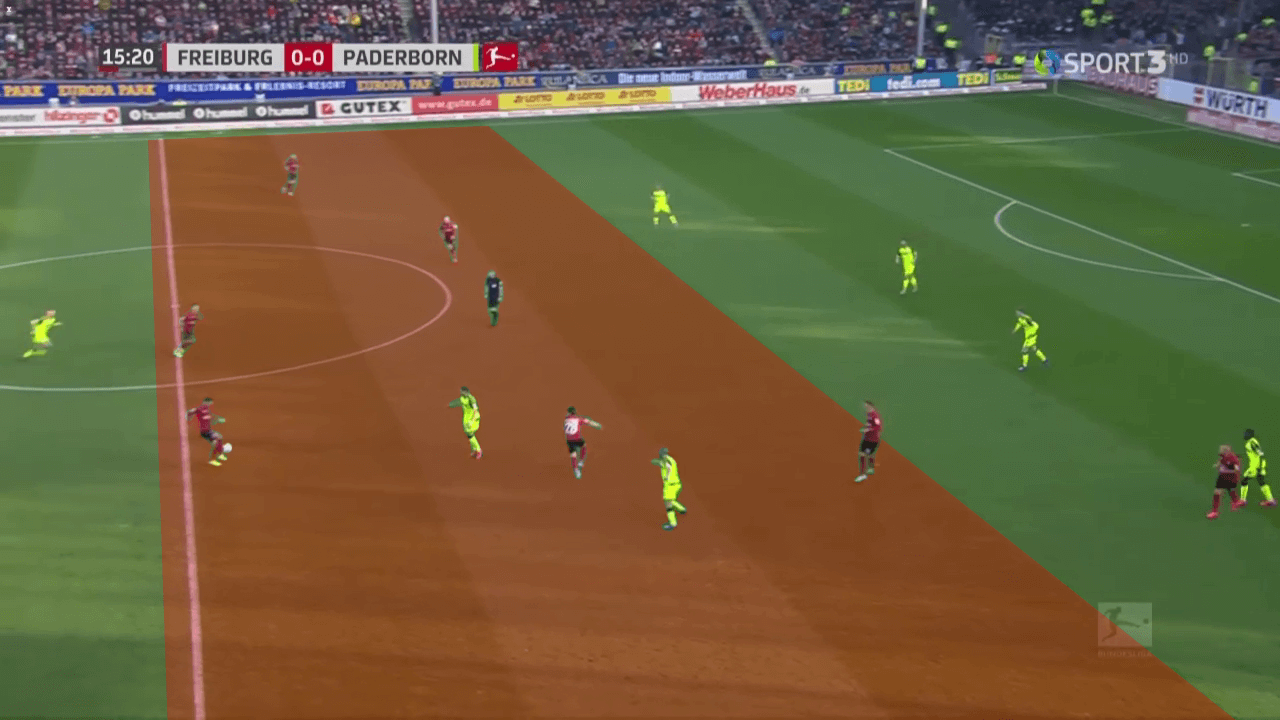
From these areas, the opposition can often score or assist as their defenders seem to be struggling with the decision of when to move out of their position to press the ball-carrier. Due to their inability to block a shot or pass, because of moving out too late, the opposition can often finish with enough time to prepare their shot. This might be one reason for Paderborn’s high number of conceded goals compared to their xGA value.
Counter-attacking
Last but not least, Paderborn is an unpleasant opponent due to their counter-attacks. Baumgart’s side immediately play forward once regaining possession and attempt to exploit the disorganisation of the opposition during transition moments.
And although they have some pacy attackers, this is not the only secret behind their threat on the counter. What makes them so threatening is the number of players that stay up the pitch during the defensive phase or immediately move forward once regaining possession. Oftentimes, Paderborn can pin back the opposition backline in a counter-attack which creates space for midfield players or wingers to progress into as the defenders are unable to step out.
Against Bayern, for instance, Paderborn could pin back the opposition backline with three attackers. As one can see below, this prevented the Bayern defenders from pressing one of those three players receiving and turning between the lines. Simultaneously their left winger quickly advances up the flank to outnumber Bayern’s defensive department on the counter.
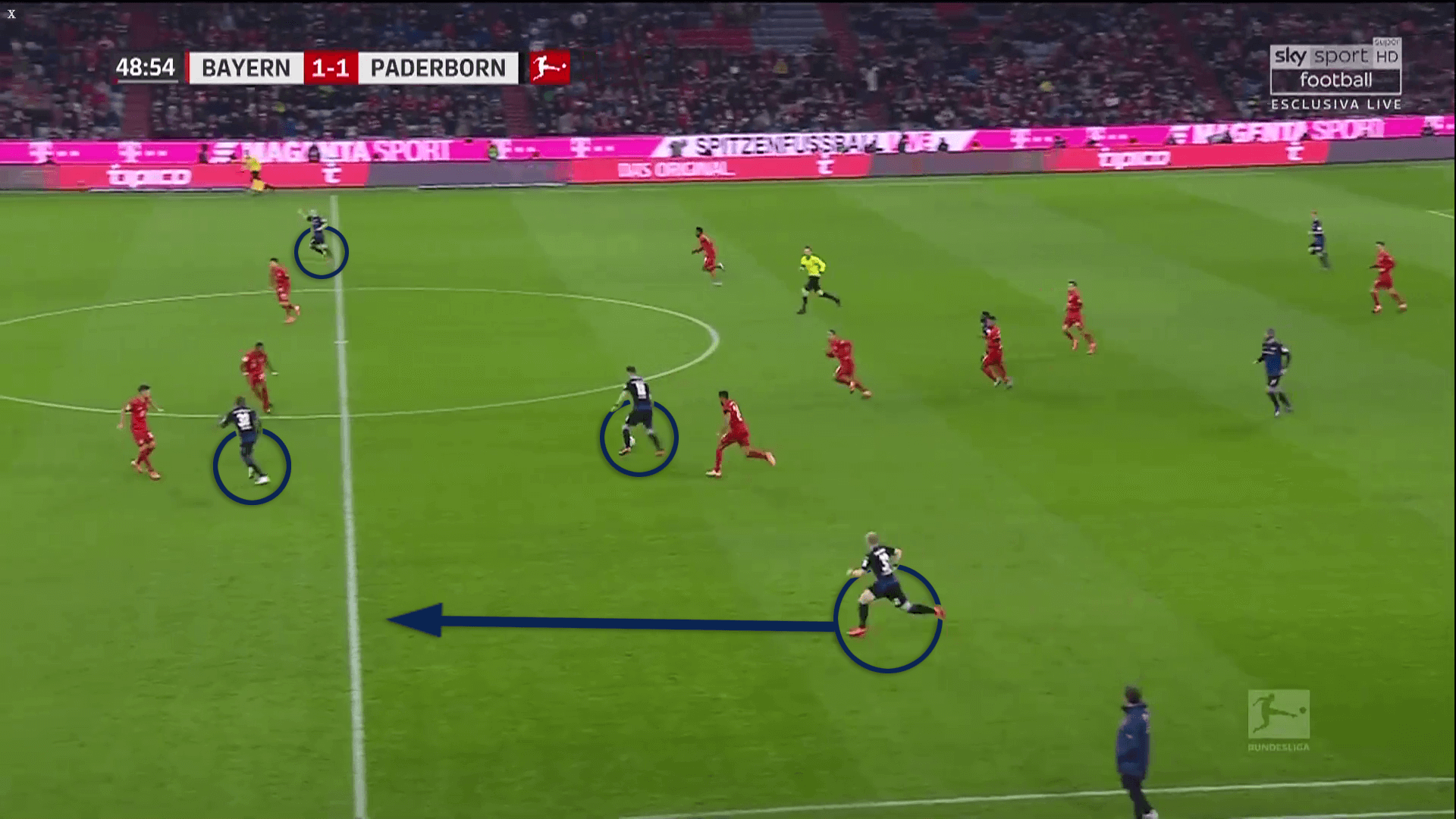
Their 3-3 draw against Borussia Dortmund was another exemplary game for their counter-attacks. They scored two of their three goals on the break exploiting the lack of pace within the Dortmund’s defensive department.
During counter-attacks, their dribblings also come into play that we already mentioned earlier in our analysis. As there is usually more space offered during transition moments, the Paderborn attackers can often take on the opposition defenders in isolated 1v1 situations.
Conclusion
In our analysis, we mainly focused on Paderborn’s attacking and defending philosophy under Steffen Baumgart which include playing out from the back, positional play, overloads and an active pressing approach.
All in all, despite their unfavourable situation in the Bundesliga table, Paderborn are a joy to watch under current manager Baumgart. Although playing a league higher compared to the 2. Bundesliga last season, the head coach, team and club remained true to their principles and have stuck to their courageous style of play. Nevertheless, we also shed a light on some of their issues such as the lack of vertical compactness during the defensive phase and their shot selection in the attack.





Comments